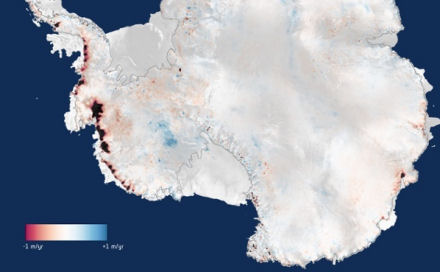22 May 2015
Sudden increase in ice loss in Antarctica
by Will Parker
An international group of scientists has observed a sudden increase in ice loss on the Southern Antarctic Peninsula, what was previously thought to be a stable region of Antarctica. Led by scientists from the University of Bristol (UK), the group has published their observations in the latest edition of Science.

Using measurements of the elevation of the Antarctic ice sheet made by a suite of satellites, the researchers found that the Southern Antarctic Peninsula showed no signs of change up to 2009. But in 2009, multiple glaciers along a vast coastal expanse, measuring some 750km in length, suddenly started to shed ice into the ocean at a nearly constant rate of 60 cubic km, or about 55 trillion liters of water, each year.
The researchers add that the ice surface in some areas is decreasing by as much as 4 meters each year. This makes the Southern Antarctic Peninsula region the second largest contributor to sea level rise in Antarctica.
"The fact that so many glaciers in such a large region suddenly started to lose ice came as a surprise to us," said Dr Bert Wouters, a Marie Curie Fellow at the University of Bristol. "It shows a very fast response of the ice sheet: in just a few years the dynamic regime completely shifted."
Rather than changes in snowfall or air temperature, Wouters attributes the rapid ice loss to warming oceans. "Many of the glaciers in the region feed into ice shelves that float on the surface of the ocean," he explains. "They act as a buttress to the ice resting on bedrock inland, slowing down the flow of the glaciers into the ocean. The westerly winds that encircle Antarctica have become more vigorous in recent decades, in response to climate warming and ozone depletion. The stronger winds push warm waters from the Southern Ocean poleward, where they eat away at the glaciers and floating ice shelves from below."
A key concern emerging from the new findings is that much of the ice of the Southern Antarctic Peninsula is grounded on bedrock below sea level, which gets deeper inland. This means that even if the glaciers retreat, the warm water will chase them inland and melt them even more.
"It appears that sometime around 2009, the ice shelf thinning and the subsurface melting of the glaciers passed a critical threshold which triggered the sudden ice loss," said Wouters. "However, compared to other regions in Antarctica, the Southern Peninsula is rather understudied, exactly because it did not show any changes in the past, ironically."
Related:
Discuss this article in our forum
Sea-level rise predictions may be missing critical factors
Oz rains soak up sea level rise
Ocean currents explain rainfall riddle
Strangely, the loss of forests may actually be cooling the planet
Source: University of Bristol
